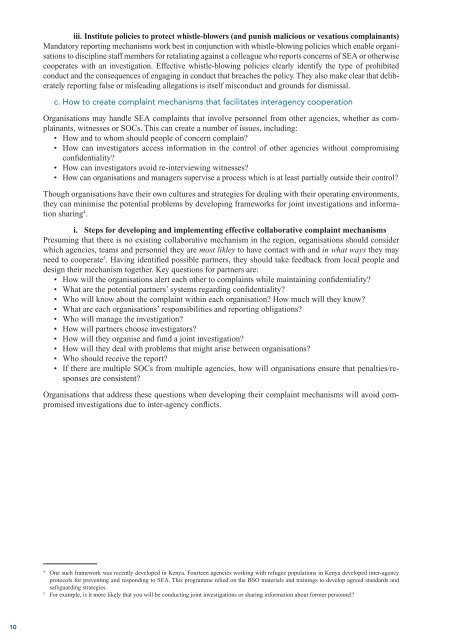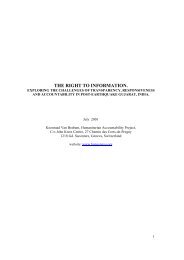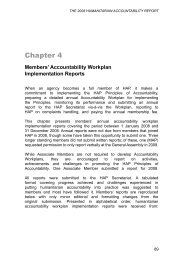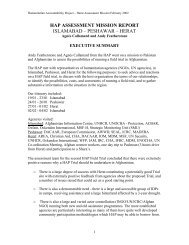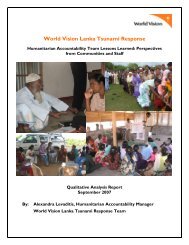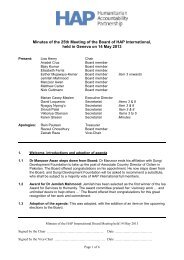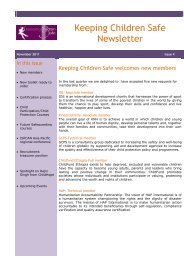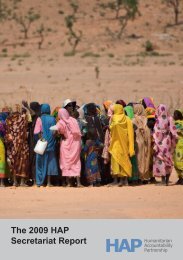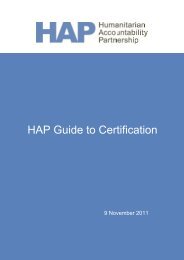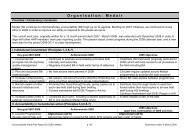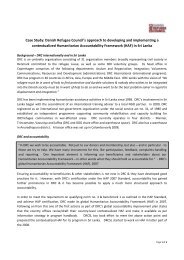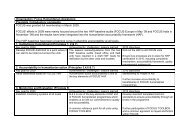Building Safer Organisations Guidelines - HAP International
Building Safer Organisations Guidelines - HAP International
Building Safer Organisations Guidelines - HAP International
Create successful ePaper yourself
Turn your PDF publications into a flip-book with our unique Google optimized e-Paper software.
iii. Institute policies to protect whistle-blowers (and punish malicious or vexatious complainants)<br />
Mandatory reporting mechanisms work best in conjunction with whistle-blowing policies which enable organisations<br />
to discipline staff members for retaliating against a colleague who reports concerns of SEA or otherwise<br />
cooperates with an investigation. Effective whistle-blowing policies clearly identify the type of prohibited<br />
conduct and the consequences of engaging in conduct that breaches the policy. They also make clear that deliberately<br />
reporting false or misleading allegations is itself misconduct and grounds for dismissal.<br />
c. How to create complaint mechanisms that facilitates interagency cooperation<br />
<strong>Organisations</strong> may handle SEA complaints that involve personnel from other agencies, whether as complainants,<br />
witnesses or SOCs. This can create a number of issues, including:<br />
• How and to whom should people of concern complain?<br />
• How can investigators access information in the control of other agencies without compromising<br />
confidentiality?<br />
• How can investigators avoid re-interviewing witnesses?<br />
• How can organisations and managers supervise a process which is at least partially outside their control?<br />
Though organisations have their own cultures and strategies for dealing with their operating environments,<br />
they can minimise the potential problems by developing frameworks for joint investigations and information<br />
sharing 4 .<br />
i. Steps for developing and implementing effective collaborative complaint mechanisms<br />
Presuming that there is no existing collaborative mechanism in the region, organisations should consider<br />
which agencies, teams and personnel they are most likley to have contact with and in what ways they may<br />
need to cooperate 5 . Having identified possible partners, they should take feedback from local people and<br />
design their mechanism together. Key questions for partners are:<br />
• How will the organisations alert each other to complaints while maintaining confidentiality?<br />
• What are the potential partners’ systems regarding confidentiality?<br />
• Who will know about the complaint within each organisation? How much will they know?<br />
• What are each organisations’ responsibilities and reporting obligations?<br />
• Who will manage the investigation?<br />
• How will partners choose investigators?<br />
• How will they organise and fund a joint investigation?<br />
• How will they deal with problems that might arise between organisations?<br />
• Who should receive the report?<br />
• If there are multiple SOCs from multiple agencies, how will organisations ensure that penalties/responses<br />
are consistent?<br />
<strong>Organisations</strong> that address these questions when developing their complaint mechanisms will avoid compromised<br />
investigations due to inter-agency conflicts.<br />
4<br />
One such framework was recently developed in Kenya. Fourteen agencies working with refugee populations in Kenya developed inter-agency<br />
protocols for preventing and responding to SEA. This programme relied on the BSO materials and trainings to develop agreed standards and<br />
safeguarding strategies.<br />
5<br />
For example, is it more likely that you will be conducting joint investigations or sharing information about former personnel?<br />
10


